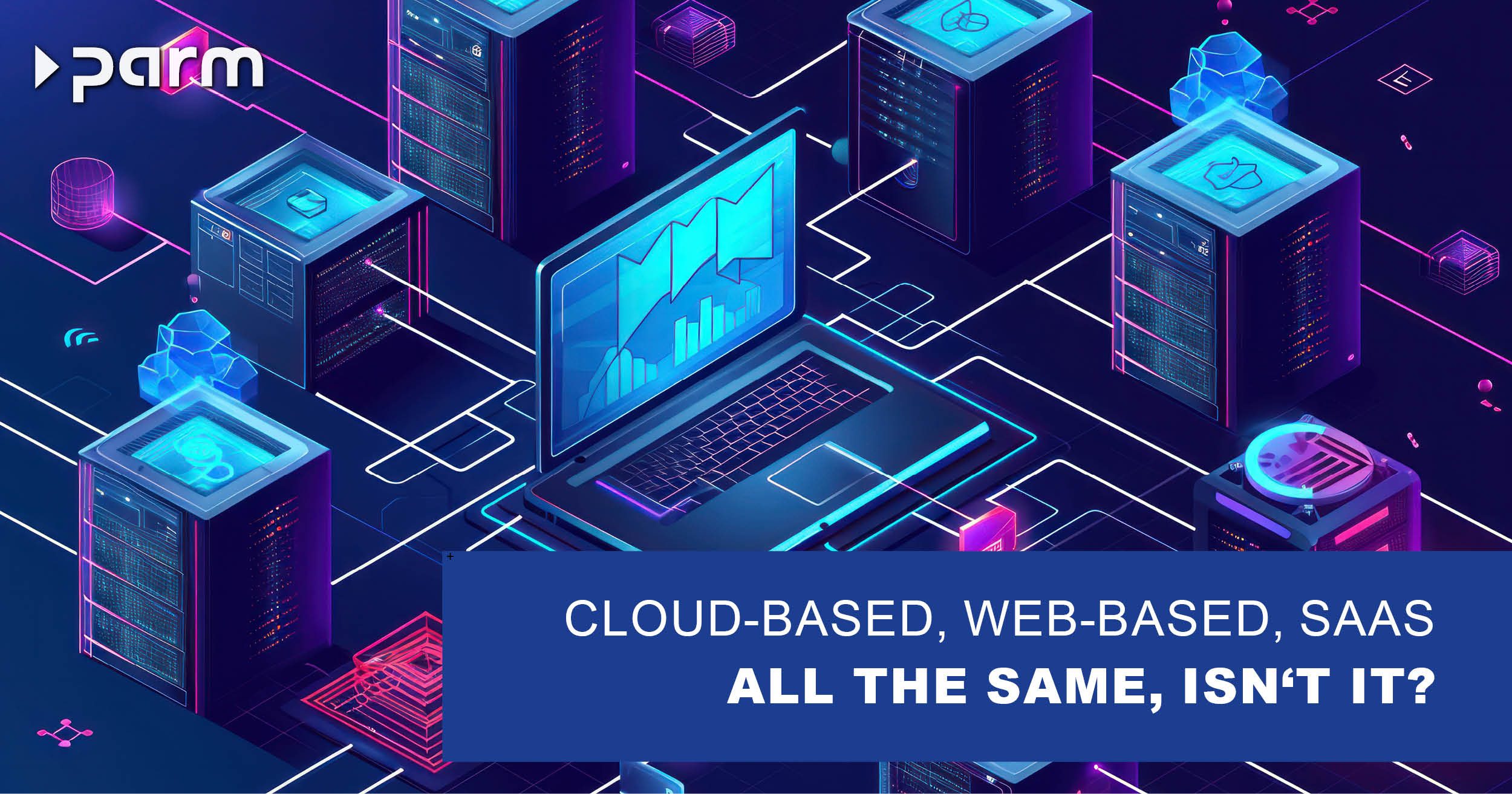Cloud-based, web-based or as Software-as-a-Service (SaaS) – all the same, isn’t it?

Modern software, such as that offered by Parm AG, is often cloud-based, web-based or available as Software-as-a-Service (SaaS). But aren’t these three different terms that all describe the same thing? No! We explain the differences and why it’s important to know them.
What are cloud-based, web-based and SaaS?
There is some overlap between the terms cloud-based, web-based and SaaS, which is why they are often used interchangeably. However, this is not entirely correct and can lead to misunderstandings when purchasing software, for example. So let’s take a closer look at what the three terms mean:
- Cloud-based: A cloud-based system means that the resources (such as computing power, storage, applications, etc.) are provided via the Internet, or more precisely, via a cloud. These resources are usually managed by third-party providers and can thus be hosted on remote servers that are accessed via the Internet. Cloud-based systems usually offer high scalability and flexibility, as well as the ability to access them from anywhere without having to provide or maintain your hardware.
- Web-based: A web-based system is an application or software that is accessed via a web browser. This means that the entire user interface and functionality are provided via the browser, so no local installation or downloads are required. Web-based systems can be hosted both locally (on a company server, for example) and in the cloud. They offer universal access across a wide range of devices and operating systems, as only a browser and possibly an internet connection are required to access the application.
- SaaS (Software-as-a-Service): SaaS is a specific form of software provision via the Internet. With SaaS applications, the software is hosted centrally and made available via the Internet. Users can therefore access the software via the Internet without having to install it locally. SaaS applications are usually offered via a subscription model where users pay to use the software instead of buying it.
The similarities
So, although cloud-based, web-based, and SaaS are different concepts, there are certain areas where these terms overlap and mean that the terms are often used interchangeably:
- Internet-based provision: All three concepts involve the provision of resources or services via the Internet. Cloud-based services use the internet to provide various types of resources such as computing power and storage. Web-based applications offer their functionality via the web without the need for a local installation. SaaS applications are also provided via the internet and can be subscribed to by users via a web browser.
- Abstraction of hardware and infrastructure: With all three concepts, users do not have to worry about the physical provision or maintenance of hardware, servers, and infrastructure, as these tasks are usually taken over by the provider.
- Scalability and flexibility: All three concepts offer scalability and flexibility. Cloud-based services allow users to scale resources as required. Web-based applications can be accessed by users across different devices and operating systems. SaaS applications offer a flexible subscription structure that allows users to customize their usage according to their needs.
- Access from anywhere: Another point of overlap is universal access from anywhere. Users can access cloud-based services, web-based applications, and SaaS applications from any location that has an internet connection. This enables users to work on the move and access their data and applications from different locations.
The subtle differences
The differences between the three terms lie in the details. For example, you can assume that access to an application in cloud-based systems generally takes place via an internet connection. However, this does not necessarily apply to web-based software, even if the term suggests this. One example of this is the myPARM project management software. It is web-based, which means that you can access and use it via your browser. However, the software does not necessarily have to be operated via a cloud. Instead, it can also be hosted on-premise, i.e. on your company’s servers. In this case, you may be able to use the software without having an internet connection.
Conversely, cloud-based software is not necessarily web-based, even if this also seems obvious. Apps that you use on your smartphone, for example, are usually cloud-based. However, as these services can only be used with the app and not via a browser, they are not web-based at the same time.
SaaS, on the other hand, is simply a subscription to a software service. This requires neither a cloud-based nor a web-based application. A local installation for which you pay a monthly or annual fee is also considered Software-as-a-Service. This can be software such as Microsoft Office 365, for example, which you can subscribe to and then either install locally on your computer or use web-based.
Conclusion
Cloud-based, web-based, and SaaS solutions play a crucial role in the provision of services and applications. While cloud-based services provide resources such as computing power and storage over the Internet, web-based applications enable universal access across different devices. SaaS applications offer a flexible subscription structure for accessing software over the internet without the need for local installations. The diversity of these technologies helps to provide businesses and users with innovative solutions tailored to their specific needs.
Parm AG’s web-based software offers a versatile and flexible solution that can be deployed either in a cloud environment, locally hosted, or as a SaaS offering, depending on the customer’s needs. This flexibility allows companies to use the software according to their preferences and requirements, e.g. in terms of data protection, while benefiting from the advantages of web-based deployment. With its web-based architecture, Parm AG’s software ensures that users can access their data and applications from anywhere while allowing the software to be run in different environments to meet customers’ individual needs.
Learn more about the project and portfolio management software myPARM:
Would you like to get to know myPARM in a demo presentation? Then make an appointment with us right away!
